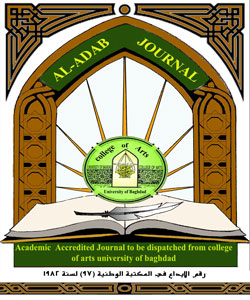Festive movie features
DOI:
https://doi.org/10.31973/aj.v0i133.911Keywords:
الفيلم, الاحتفالي, سماتAbstract
The topic of the features of the festive movie was not raised previously, nor was it established and prepared for it, therefore there is a precedent and difficulty in establishing and elaborating the features of this type of film, especially in the works of Prince of Costa Rica that have common features that we can call festive, which are different from the storytelling or watching. Or carnival, although all of these designations extend their roots to the ceremonial rituals of the peoples, which were embodied in the (Akito) ceremonies of the Babylonians, and the Greeks in the celebrations of Bakhos, as well as associated with rituals and festivals, which later turned to include festivals and worldly ceremonies. From its inception in the Greek incubator, the theater presented patterns of ceremonialness in the theater, specifically its first beginnings with the choir, and then the emergence of the single actor alternating with the choir. There is also the name of the ceremonial theater. But in the cinema, which is the most recent history of the theater that is deeply rooted in history, many directors have presented films bearing the characteristics of celebration, storytelling, spectacle and carnival.
Downloads
References
Aslan, Martin, Anatomy of Drama, Ter Youssef Abdel-Messih Tharwa, 2nd Baghdad, 1984.
Omon, Jack, and others, Film Analysis, Ter: Antoine Homsi, Damascus, Ministry of Culture Publications, 1999.
Bart, Roland, Criticism and Truth, Tert: Munther Ayyash, Arab Organization for Translation, Paris, 1994
Boggs, Joseph. M., The Art of Farjah, Ter: Wedad Abdullah, The Egyptian General Book Authority, Cairo, 1995
Jacob, Lewis, Film Mediator, Ter: Abaya Hamzawy, General Film Foundation, Damascus, 2006
Janetti, Lowe, D., Understanding Cinema, T .: Ja`far Ali, Dar Al-Rashid, Baghdad, 1981
Ricoeur, Paul, Time and Narration, Part 1, T .: Saeed Al-Ghanmi and Falah Rahim. 2005.
Al-Zein, Mohamed Shawky, Interpretations and Decompositions, The Arab Cultural Center, Casablanca / Beirut 2002.
Abdel Wahid, Ali, Al-Wafi, Ancient Greek Literature, Dar Al-Maarif, Egypt 1960.
Gadamir, H.J. Truth and Approach, see: Hassan Nazem and Ali Hakem, Uriah House, Libya, 2007
Gadamir, HJ, Tajalli Al-Jameel, Ter: Saeed Tawfiq, The Supreme Council of Culture, Cairo, 1997.
Qara, Nabiha, Philosophy and Interpretation, Dar Al-Tale'ah for Printing and Publishing, Beirut 1988.
Lordova, Dina, Emir of Costa Rica, Ter: Ammar Ahmed Hamid, General Film Foundation, Damascus 2010.
Mustafa Ibrahim and Others, The Intermediate Dictionary, Islamic Library, Turkey, 2000.
Elias, Mary, and Hanan Kassab, The Theatrical Lexicon, Lebanon Library, Lebanon, 1997.
Downloads
Published
Issue
Section
License
Copyright and Licensing:
For all articles published in Al-Adab journal, copyright is retained by the authors. Articles are licensed under an open access Creative Commons CC BY 4.0 license, meaning that anyone may download and read the paper for free. In addition, the article may be reused and quoted provided that the original published version is cited. These conditions allow for maximum use and exposure of the work.
Reproducing Published Material from other Publishers: It is absolutely essential that authors obtain permission to reproduce any published material (figures, schemes, tables or any extract of a text) which does not fall into the public domain, or for which they do not hold the copyright. Permission should be requested by the authors from the copyrightholder (usually the Publisher, please refer to the imprint of the individual publications to identify the copyrightholder).
Permission is required for: Your own works published by other Publishers and for which you did not retain copyright.
Substantial extracts from anyones' works or a series of works.
Use of Tables, Graphs, Charts, Schemes and Artworks if they are unaltered or slightly modified.
Photographs for which you do not hold copyright.
Permission is not required for: Reconstruction of your own table with data already published elsewhere. Please notice that in this case you must cite the source of the data in the form of either "Data from..." or "Adapted from...".
Reasonably short quotes are considered fair use and therefore do not require permission.
Graphs, Charts, Schemes and Artworks that are completely redrawn by the authors and significantly changed beyond recognition do not require permission.
Obtaining Permission
In order to avoid unnecessary delays in the publication process, you should start obtaining permissions as early as possible. If in any doubt about the copyright, apply for permission. Al-Adab Journal cannot publish material from other publications without permission.
The copyright holder may give you instructions on the form of acknowledgement to be followed; otherwise follow the style: "Reproduced with permission from [author], [book/journal title]; published by [publisher], [year].' at the end of the caption of the Table, Figure or Scheme.












